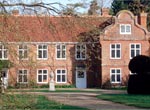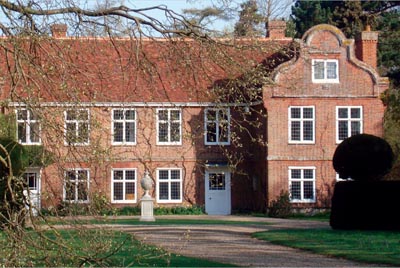Country houses for sale in Essex
Country houses in Essex traditionally appeal to those who work in the City, and there are some very fine examples on the market


The prolific wine and gardening author Hugh Johnson tends to take a long-term view. In 1971, after years of painstaking research, his seminal work The World Atlas of Wine was published by Mitchell Beazley. Forty years and four million copies later, the book, now in its sixth edition, is still considered to be the most important publication ever written on the subject. Mr Johnson is equally passionate about gardening-trees in particular-and a totally new edition of his International Book of Trees, first published in 1973, was successfully launched in October 2010 as Trees-A Lifetime's Journey through Forests, Woods and Gardens.
Much of that ‘lifetime's journey' has revolved around the magnificent gardens and arboretum created by Mr Johnson in the 12 acres surrounding Grade II*-listed Saling Hall, near Braintree, Essex, the exquisite Elizabethan manor house he and his wife, Judy, bought in late 1970, and which they are now selling through Savills (020-7409 8885) at a guide price of £2.6 million. First launched on the market in March this year, Saling Hall has seen a steady stream of prospective purchasers arriving to view, although so far none has got as far as putting pen to paper.
Typically, Mr Johnson is philosophical about the leisurely rate of progress: ‘Perhaps people are frightened by the prospect of taking on two gardeners and the arboretum-who knows? But several of our friends have recently sold their houses, so we're quite happy to sit tight and wait for the right person to come along. We've been so happy here-it's a marvellously friendly house that feels as if it's always been a happy place to live in.'

Eloquent sales particulars describe Saling Hall (pictured) as ‘an Elizabethan manor house in late 17th century costume, the quintessence of English country comfort dressed up as a miniature stately home'. Certainly, with 27 rooms on three floors and two wine cellars, its 9,385sq ft of living space offers ample room for manoeuvre. The hall stands beside Saling's ancient village church, and consists of three wings surrounding a brick-paved rear yard. As in many Elizabethan houses of standing, its first-floor rooms, with their unusually high ceilings, constitute a sort of piano nobile. Just as unusual are the two matching front doors, created in 1795 when the hall was shared by two sisters married to naval officers, who were often away at sea. The ground floor, with its two halls and two staircases, still shows signs of that 18th-century division.
The manor of Saling dates from the 12th century, but the house was built in about 1570, and remodelled in the Dutch style in 1699 by Martin Shalford, who also built the walled garden. The west wing contains the oak-panelled drawing room, the sitting room, the present kitchen and a fine staircase with turned balusters. Other original rooms include the master suite, three other bedrooms, a bathroom and a study, linked by corridors added in the 19th century. The ground floor of the east wing contains the entrance hall, the library and the study that faces east across the moat. Upstairs are the Chinese morning room, the principal guest bedroom and two other bathrooms.
For more than 30 years, the gardens and grounds at Saling Hall provided the background to Mr Johnson's ‘Trad's Diary' in the RHS's magazine The Garden, its title inspired by John Tradescant, gardener to James I and Lord Cecil of Hatfield House, and one of the first to introduce foreign plants to English gardens. As well as its famous arboretum, Mr Johnson's garden incorporates notable work done by Lady Carlyle, his predecessor at Saling Hall, in addition to his own prodigious, year-round planting. Highlights include the classical Temple of Pisces, a horseshoe pond known as the Red Sea, a Japanese water garden, the Millennium Stone (a granite monolith from Snow-donia) and a pool enclosed by 10ft-high yew hedges. It all adds up to a living encyclopaedia of horticultural knowledge, and a testament to a lifelong commitment to gardening excellence.
Selling agent William Duckworth-Chad of Savills is also confident of finding ‘the right buyer' for Saling Hall, given the sustained level of interest it continues to generate. But he's realistic enough to admit that ‘compared with the inner Home Counties, the market for anything rural to the north and east of London has been incredibly difficult this year especially in Essex, where most good houses tend to be bought by Essex people with City connections, and confidence in the City is at a low ebb'.
Sign up for the Country Life Newsletter
Exquisite houses, the beauty of Nature, and how to get the most from your life, straight to your inbox.
It's still early days, but this may also be affecting impressive, Grade II*-listed Durrington House at Sheering, near Sawbridgeworth, Essex, five miles from the M11, 11 miles from Stansted and 27 miles from Canary Wharf, for which Savills quote a guide price of ‘excess £5m'. Built in the mid-1700s on the site of an earlier Tudor house for Samuel Feake, a director of the ill-fated South Sea Company, Durrington House has evolved over the years, being substantially altered in the 18th and 19th centuries, and again in the 1960s, when it was extensively modernised by the architect Anthony Lloyd.
Like many important Essex houses, Durrington has impeccable City connections, having been home to several well-known banking families, among them the Glyns (co-founders of Williams & Glyn's Bank, now part of RBS), the Goschens and the Hambros. Novelist and scriptwriter Elinor Glyn, the pioneer of mass-market women's erotic fiction whose racy novels inspired the verse: ‘Would you like to sin/With Elinor Glyn/On a tiger skin?/Or would you prefer/To err with her/On some other fur?' is thought to have lived at Durrington House at the turn of the 20th century.
For sale for the first time in more than 50 years, Durrington House has been home to two generations of Hambros, who have maintained the property in pristine condition throughout their tenure. Set in 46 acres of immaculate gardens, pasture, farmland and woodland, the house has four splendid reception rooms, 10 main bedrooms, five bathrooms and seven second-floor rooms. Ancillary buildings include four cottages, a former stable courtyard, a carriage house, a range of garden sheds and an old cowshed with potential for redevelopment.
* Give Country Life for Christmas and save up to 40%
Country Life is unlike any other magazine: the only glossy weekly on the newsstand and the only magazine that has been guest-edited by HRH The King not once, but twice. It is a celebration of modern rural life and all its diverse joys and pleasures — that was first published in Queen Victoria's Diamond Jubilee year. Our eclectic mixture of witty and informative content — from the most up-to-date property news and commentary and a coveted glimpse inside some of the UK's best houses and gardens, to gardening, the arts and interior design, written by experts in their field — still cannot be found in print or online, anywhere else.
-
 'Monolithic, multi-layered and quite, quite magnificent. This was love at first bite': Tom Parker Bowles on his lifelong love affair with lasagne
'Monolithic, multi-layered and quite, quite magnificent. This was love at first bite': Tom Parker Bowles on his lifelong love affair with lasagneAn upwardly mobile spaghetti Bolognese, lasagne al forno, with oozing béchamel and layered meaty magnificence, is a bona fide comfort classic, declares Tom Parker Bowles.
By Tom Parker Bowles Published
-
 Country houses, cream teas and Baywatch: Country Life Quiz of the Day, April 24, 2025
Country houses, cream teas and Baywatch: Country Life Quiz of the Day, April 24, 2025Thursday's Quiz of the Day asks exactly how popular Baywatch became.
By Toby Keel Published
